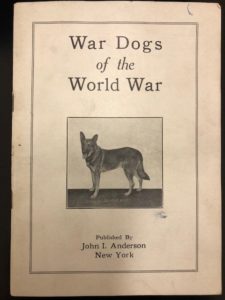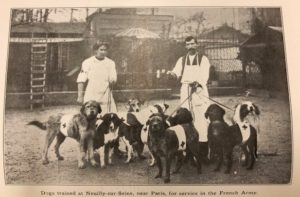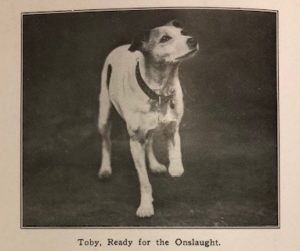Must Love Dogs: 11/11/18
In 1918, at the eleventh hour of the eleventh day of the eleventh month, an armistice was signed between the Allies and Germany, effectively ending World War I. This Saturday marks the anniversary of this event, commemorated as Veteran's Day in the United States, Armistice Day in France, and Remembrance Day in the United Kingdom. In honor of this event, our November Dog Book series blog post highlights a booklet about some of the dogs of World War I.


"War Dogs of the World War," published in 1919, is dedicated "To those who love dogs, those faithful friends of mankind." In 1914, animal lover Countess Mary Yourkevitch (a native-born Russian who made France her adopted home), established the Refuge in Neuilly, a training school whose sole purpose was to train dogs for war work. Some were trained to work for the Red Cross, some for trench work, and others became messengers. Six hundred dogs were trained and sent to the Front. Some made the ultimate sacrifice; some returned crippled; and some returned unscathed, at least physically. After the war's end, dozens of these dogs returned to the Countess's care. John I. Anderson, the author of the booklet, wrote, "Knowing the burden placed upon her, both in a financial and physical sense, I am writing this story of the heroic deeds of these wonderful animals. Every penny derived from the sale of this booklet will be devoted to assist this noble work of the Countess Yourkevitch of Neuilly, France." To be honest, several of his stories of individual dogs are truly heartbreaking, such as that of Monte, who worked as a picket dog and returned to France after four years of service, suffering from shell shock and completely traumatized.

However, Anderson also introduces us to Toby, the fox terrier whose job was to keep the trenches free of rats. Toby served three years at the Front and is credited with killing four thousand rats during that time. He was returned to the Countess after a stray bullet cost him part of a leg. Despite his energy, Anderson describes Toby as the "most agile three-footed tyke I ever saw, and sets the pace for all the other dogs in their gambols about the grounds." We also learn that the soldiers taught Toby some tricks, including saying his prayers, rolling over, and singing.

Anderson also describes meeting Dick, a French poodle, who had worked for two years as a guide at the Soldiers' Home for the Blind. Anderson writes, "It is no unusual sight to see two men or more, arm in arm, being guided by Dick through various parts of the grounds. Sometimes you meet them picking their way through the adjacent streets, Dick always on the alert for their safety."

It's only fitting that we take the time to also remember and acknowledge the service of military dogs this Saturday. "War Dogs of the World War" is just one of many titles associated with war dogs. If you are interested in learning more about our holdings, please visit the W&M Libraries online catalog or visit us in Special Collections. We'll be happy to help you!

